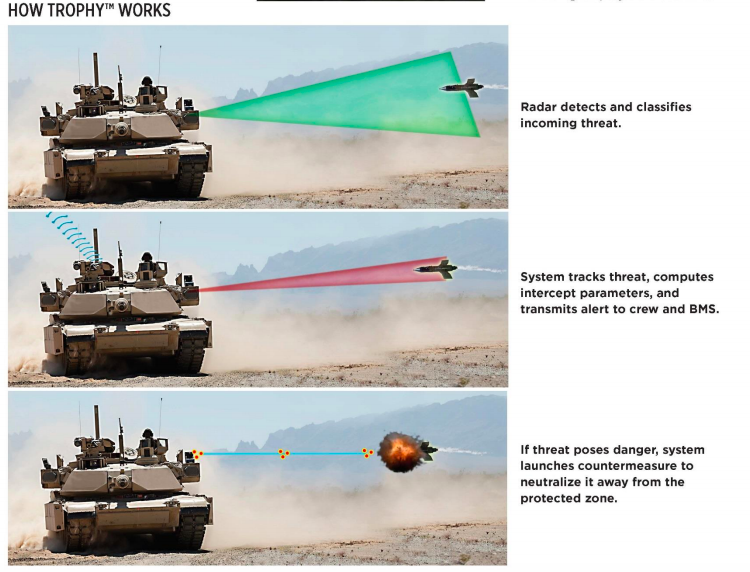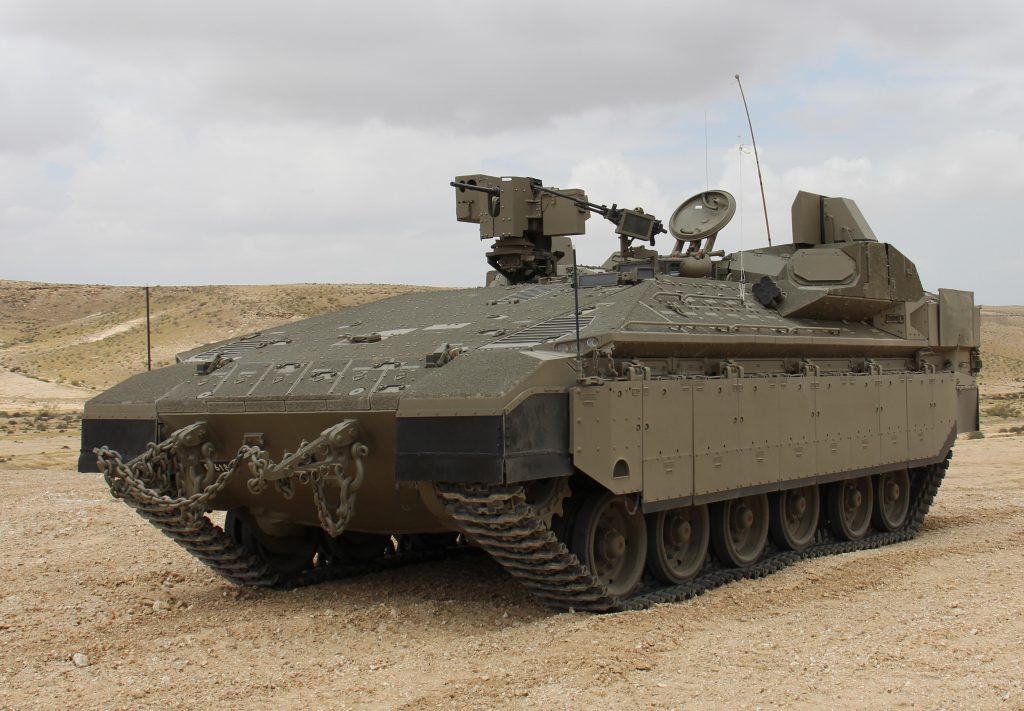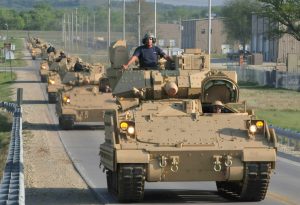Trophy APS For Everyone? A Streamlined Version For M2 Bradley
Posted on
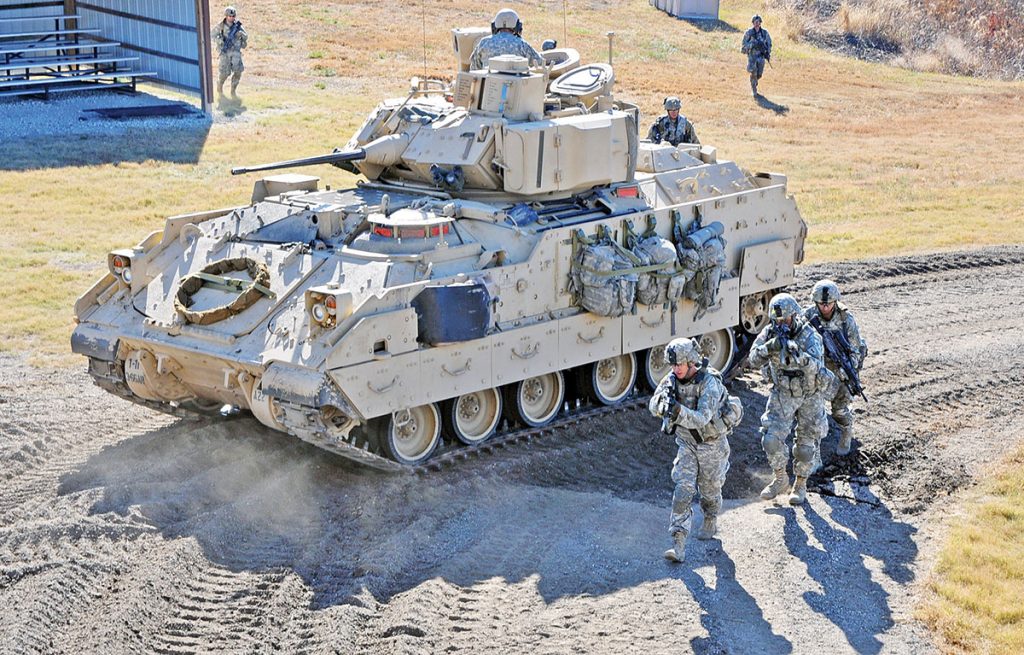
US Army soldiers train with an M2 Bradley IFV (Infantry Fighting Vehicle). Active Protection Systems that shoot down incoming anti-tank missiles must be carefully designed to avoid killing nearby friendly infantry.
Even as the US Army races to install Trophy Active Protection Systems on its M1 Abrams heavy tanks, Trophy’s manufacturers are testing slimmed-down versions they want to sell the US for lighter vehicles, especially the aging M2 Bradley troop carrier.
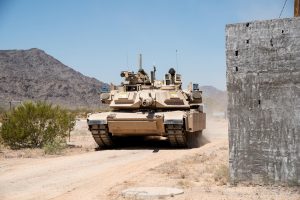
US Army M1 Abrams tank with Trophy Active Protection Systems (APS) and improved protection for machinegun operator.
While other technologies look promising, Trophy is still the only non-Russian system that’s combat-proven to shoot down incoming anti-tank rockets and missiles. What’s more, US Army testing of the rival IMI Iron Fist (also Israeli) on the Bradley has fallen behind schedule. Part of the delay was due to funding — money happened to be available to start Trophy testing earlier — but I keep hearing rumors that Iron Fist is having technical challenges as well.
So Israel-based Rafael and its US partner Leonardo DRS are increasingly emboldened to make a move on middle-weight armored vehicles like Bradley. Rafael is also developing an entirely different kind of APS for light armored vehicles, but this project is less far along.
Speed is crucial because the US Army is in a ferocious hurry to field Active Protection Systems in case Russia’s armored legions start rolling west. After a streamlined initial characterization effort — the Army very deliberately didn’t call it “testing” — proved Trophy could work on Abrams, the Army signed an “undefinitized” contract. Exact terms are still being worked out, which could take up to six months, but the Army is eager to accelerate and Leonardo promises fielding will begin early in calendar year 2019.
So great is the Army’s rush that it’s conducting in-depth testing at the same time as production. That’s not best practice — ideally, you want to work out all the bugs before you begin buying — but it’s become common on far more complex technologies than Trophy, most infamously the F-35 Joint Strike Fighter.
While Army Chief of Staff Mark Milley wants APS in every brigade, current budget plans fund enough Trophy systems for every M1 tank in four armored brigades. (One is bought with 2018 money, the rest in 2019). That’s the same version of the system installed on Israeli Merkava tanks and Namer heavy troop carriers, now known as Trophy-HV, for Heavy Version: Rafael says this model weighs about 1,800 pounds, depending on details of the installation, while the Pentagon’s independent Director of Operational Test & Evaluation put the total installation at 5,000 lbs. That might seem like a marginal increase for a 70-ton tank, but that weight has to go on top of the tank, potentially affecting the balance and turn rate of the turret — a problem that arose (but was resolved) early in Trophy testing on the M1.
There’s also the issue of electrical power for the requisite radars and jammers. The US Army’s armored vehicles were designed in the 1970s when electronics were much less important. While they’ve been upgraded, M2 Bradleys in particular are reported to suffer brownouts when crews have to turn off one piece of equipment to power the others.
“There are those who have concerns with Trophy’s space, weight, and power (SWAP) requirements as it is currently fielded on Merkava, Namer, and soon Abrams,” said Michael O’Leary, director of business development for survivability and lethality systems at Leonardo DRS. “It’s not a new perception, and we’ve been working for a number of years now to reduce that SWAP to make it more amenable for lighter platforms.”
“We have already developed a smaller, lighter, but equally effective Trophy system that operates in the exact same manner, with no degradation in performance, exact same algorithms, exact same threats defeated,” O’Leary told me. Originally called Trophy-MV (Medium Version), it’s now being branded as Trophy-VPS (Vehicle Protection System). Rafael’s official weight figure for VPS is about 1,100 pounds, but O’Leary explained the slimmed-down version cuts size and weight by anywhere from 25 to 40 percent, depending on the details of how it’s installed on a particular vehicle.
“Power demand is about the same,” O’Leary admitted, but Trophy VPS will work on the current model of the Bradley, the M2A3, without having to turn other systems off. By contrast, the Army felt compelled to test Iron Fist on an upgraded Bradley that has some of the power enhancements of the future M2A4 model. Leonardo DRS has lots of experience working on Bradleys, O’Leary told me — “we actually provide the power management subsystem,” he said — so they’re been able to figure out how to get Trophy-VPS to work on even the “worst case” configurations.
Next month, Rafael will test the streamlined Trophy-VPS on an Israeli-owned Bradley: While it’s not an actual US Army vehicle, it’s a representative test platform, O’Leary said. If the US Army is interested, of course, Rafael and Leonardo will gladly participate in official tests.
At the same time, Rafael is also working on Trophy-LV (Light Version), which despite the name is an entirely different system that kills incoming missiles a different way. Standard Trophy shoots down threats some distance from the protected vehicle, which requires a fairly powerful projectile. “Curtain” systems like the Artis Iron Curtain and Trophy-LV fire directly down (or up) at the incoming warhead just inches from the protected vehicle. That minimizes the risk of collateral damage to nearby civilians or friendly infantry, but increases the risk of shrapnel getting through.
For now, Rafael’s focusing on the heavier shoot-down-at-a-distance systems, which it considers more capable. It plans to keep upgrading Trophy-VPS as threats advance. It’s even looking at options to build the system in the United States, although for now the only production line’s in Israel. Because of requirements that Israel spend US-provided Foreign Military Financing on US subcontractors, however, about 60 percent of Trophy (by value) is already made in the US.
Subscribe to our newsletter
Promotions, new products and sales. Directly to your inbox.

